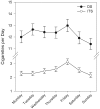Smoking patterns and stimulus control in intermittent and daily smokers
- PMID: 24599056
- PMCID: PMC3943840
- DOI: 10.1371/journal.pone.0089911
Smoking patterns and stimulus control in intermittent and daily smokers
Abstract
Intermittent smokers (ITS) - who smoke less than daily - comprise an increasing proportion of adult smokers. Their smoking patterns challenge theoretical models of smoking motivation, which emphasize regular and frequent smoking to maintain nicotine levels and avoid withdrawal, but yet have gone largely unexamined. We characterized smoking patterns among 212 ITS (smoking 4-27 days per month) compared to 194 daily smokers (DS; smoking 5-30 cigarettes daily) who monitored situational antecedents of smoking using ecological momentary assessment. Subjects recorded each cigarette on an electronic diary, and situational variables were assessed in a random subset (n=21,539 smoking episodes); parallel assessments were obtained by beeping subjects at random when they were not smoking (n=26,930 non-smoking occasions). Compared to DS, ITS' smoking was more strongly associated with being away from home, being in a bar, drinking alcohol, socializing, being with friends and acquaintances, and when others were smoking. Mood had only modest effects in either group. DS' and ITS' smoking were substantially and equally suppressed by smoking restrictions, although ITS more often cited self-imposed restrictions. ITS' smoking was consistently more associated with environmental cues and contexts, especially those associated with positive or "indulgent" smoking situations. Stimulus control may be an important influence in maintaining smoking and making quitting difficult among ITS.
Conflict of interest statement
Figures



Similar articles
-
Stimulus control in intermittent and daily smokers.Psychol Addict Behav. 2015 Dec;29(4):847-55. doi: 10.1037/adb0000052. Epub 2015 Feb 23. Psychol Addict Behav. 2015. PMID: 25706335 Free PMC article.
-
Intermittent and daily smokers' subjective responses to smoking.Psychopharmacology (Berl). 2017 Oct;234(19):2911-2917. doi: 10.1007/s00213-017-4682-x. Epub 2017 Jul 18. Psychopharmacology (Berl). 2017. PMID: 28721480 Free PMC article.
-
Characteristics and smoking patterns of intermittent smokers.Exp Clin Psychopharmacol. 2012 Aug;20(4):264-77. doi: 10.1037/a0027546. Epub 2012 Mar 5. Exp Clin Psychopharmacol. 2012. PMID: 22390208 Free PMC article.
-
Cigarette-derived nicotine is not a medicine.World J Biol Psychiatry. 2003 Apr;4(2):49-55. doi: 10.3109/15622970309167951. World J Biol Psychiatry. 2003. PMID: 12692774 Review.
-
The multiple facets of cigarette addiction and what they mean for encouraging and helping smokers to stop.COPD. 2009 Aug;6(4):277-83. doi: 10.1080/15412550903049181. COPD. 2009. PMID: 19811387 Review.
Cited by
-
Characteristics of intermittent smokers and their association with quit intentions in a sample of heavy-drinking HIV-infected men who have sex with men.AIDS Care. 2017 Jun;29(6):759-766. doi: 10.1080/09540121.2016.1237612. Epub 2016 Oct 2. AIDS Care. 2017. PMID: 27690619 Free PMC article.
-
Long-term Effects of Adolescent Substance Use Prevention on Participants, Partners, and their Children: Resiliency and Outcomes 15 Years Later During the COVID-19 Pandemic.Prev Sci. 2022 Oct;23(7):1264-1275. doi: 10.1007/s11121-022-01384-2. Epub 2022 May 25. Prev Sci. 2022. PMID: 35614368 Free PMC article.
-
Using Nicotine Gum to Assist Nondaily Smokers in Quitting: A Randomized Clinical Trial.Nicotine Tob Res. 2020 Mar 16;22(3):390-397. doi: 10.1093/ntr/ntz090. Nicotine Tob Res. 2020. PMID: 31125988 Free PMC article. Clinical Trial.
-
Cigarette smokers' concurrent use of smokeless tobacco: dual use patterns and nicotine exposure.Tob Control. 2021 Jan;30(1):24-29. doi: 10.1136/tobaccocontrol-2019-055345. Epub 2020 Feb 12. Tob Control. 2021. PMID: 32051253 Free PMC article.
-
Development and psychometric properties of the Smoking Restraint Questionnaire.Psychol Addict Behav. 2016 Mar;30(2):238-45. doi: 10.1037/adb0000134. Epub 2015 Nov 9. Psychol Addict Behav. 2016. PMID: 26551266 Free PMC article.
References
-
- Stolerman IP, Jarvis MJ (1995) The scientific case that nicotine is addictive. Psychopharmacology (Berl) 117: 2–10. - PubMed
-
- Benowitz N (2008) Clinical pharmacology of nicotine: implications for understanding, preventing, and treating tobacco addiction. Clin Pharmacol Ther 83: 531–541. - PubMed
-
- Russell MAH (1971) Cigarette smoking: the natural history of a dependence disorder. Br J Med Psychol 44: 1–16. - PubMed
Publication types
MeSH terms
Grants and funding
LinkOut - more resources
Full Text Sources
Other Literature Sources

